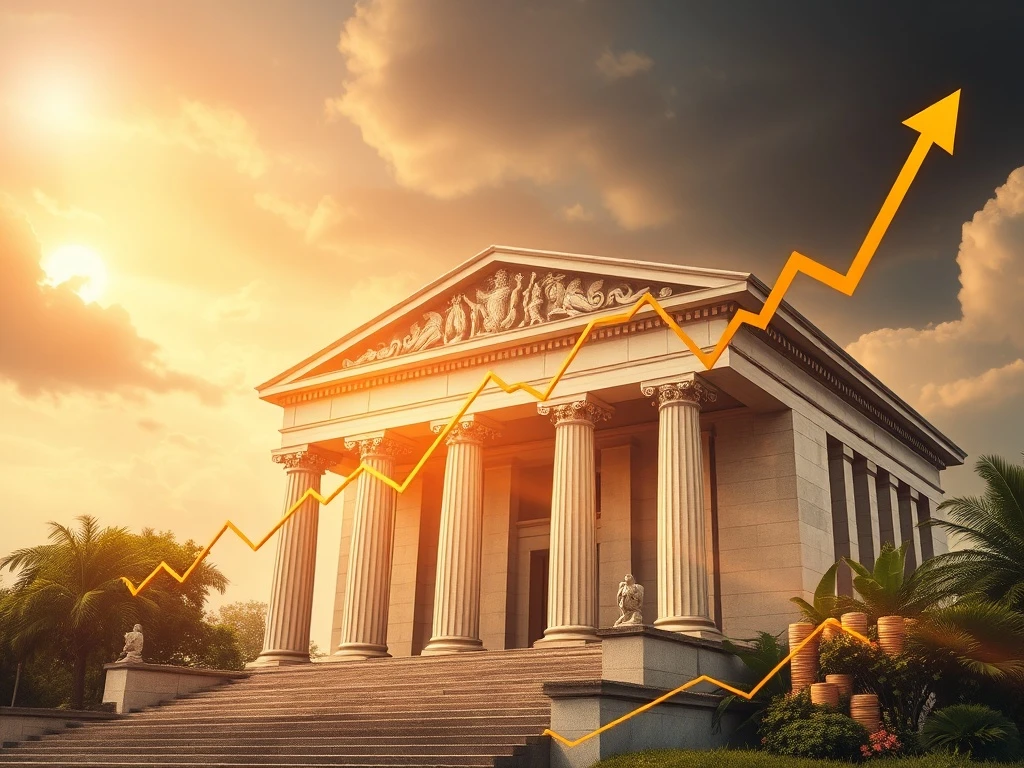Bank of America Unleashes $40B Shareholder Return Plan, Propelling BAC Shares Higher

While the cryptocurrency market often grabs headlines with its volatility and rapid innovations, it’s crucial for every savvy investor to keep an eye on the broader financial landscape. After all, the health of traditional financial giants often signals the overall economic climate that even digital assets operate within. This week, a significant announcement from **Bank of America** has sent ripples through the market, demonstrating a robust commitment to its investors. This move, centered on a massive **shareholder return** initiative, provides valuable insights into the confidence of major financial institutions and their strategic approach to capital management.
Bank of America Unleashes a Capital Avalanche: What’s Driving the Optimism?
In a significant development for the financial sector, **Bank of America (BAC)** recently unveiled an impressive $40 billion shareholder return initiative. This ambitious plan, effective August 1, 2025, received the green light from the Federal Reserve, signaling strong regulatory confidence in the bank’s financial health. At its core, the initiative features a substantial share repurchase program alongside an 8% increase in its quarterly dividend, raising it to $0.28 per share. This dividend is set to be paid on September 26, 2025, to shareholders recorded by September 5.
This new program replaces the bank’s previous buyback authorization, which had approximately $9.1 billion remaining as of June 30, 2025. The emphasis here is clear: **Bank of America** is prioritizing returning capital directly to its shareholders while meticulously adhering to regulatory requirements. Furthermore, the board approved a $1.75 per share dividend for its 7% Cumulative Redeemable Preferred Stock, Series B, payable October 24, 2025.
The execution of the share repurchase program will be flexible, utilizing various methods including open market purchases, private negotiations, and Rule 10b5-1 plans. The actual implementation will, of course, be contingent on the bank’s capital position, liquidity, and prevailing market conditions. This strategic flexibility allows Bank of America to adapt its approach to maximize value for its shareholders.
Decoding the $40 Billion Shareholder Return Strategy
Why is **Bank of America** opting for such a substantial **shareholder return** plan now? According to CEO Brian Moynihan, the move is a direct reflection of the bank’s “tremendous capital strength.” He highlighted the bank’s intent to distribute value through “progressive dividends and updated buyback authorization.” This approach is not new for the banking giant; historical precedents, such as similar initiatives in 2021 and 2023, have consistently demonstrated positive outcomes, including enhanced market stability and notable gains in banking sector equity.
The strategy is multifaceted, aiming to:
- Enhance Shareholder Value: By reducing the number of outstanding shares through buybacks, the earnings per share (EPS) typically increase, making each remaining share more valuable.
- Provide Consistent Income: The increased dividend offers a direct return to investors, particularly appealing to those seeking stable income streams.
- Signal Financial Strength: A large capital return plan signals to the market that the bank is robust, well-capitalized, and confident in its future earnings power, even after distributing significant capital.
- Optimize Capital Structure: Efficiently returning excess capital can optimize the bank’s balance sheet, ensuring capital is deployed effectively.
This disciplined approach to capital deployment underscores Bank of America’s commitment to its long-term financial health and its investors.
The Immediate Impact: Why Bank of America’s 8% Dividend Boost Matters
The announcement of the **dividend boost** had an immediate and positive effect on the market. On July 23, 2025, just days before the official announcement date of July 26, 2025, **BAC shares** surged by 1%. This immediate uptick reflects significant investor optimism regarding the bank’s capital return strategy. It’s a clear indication that shareholders are eager for direct returns and view this as a vote of confidence from the bank’s leadership.
Beyond the immediate surge, the long-term performance of BAC shares paints a compelling picture. Over the five years ending July 2025, the stock delivered an impressive 115.48% total return, showcasing consistent growth and resilience. Furthermore, the company’s shares had already gained 10% year-to-date by late July 2025, a performance driven by strategic investments and diligent cost management. This consistent performance, coupled with the new dividend and buyback program, solidifies Bank of America’s position as a stable investment in the financial sector.
For income-focused investors, an 8% dividend increase is particularly attractive, providing a more substantial return on their investment. This move aligns with broader trends in the financial sector, where institutions are increasingly rewarding shareholders amidst improving economic conditions and strong balance sheets.
Strategic Capital Allocation: Navigating Economic Headwinds
Bank of America’s strategy is not just about returning capital; it’s a testament to its disciplined **capital allocation**. The bank focuses on balancing growth initiatives, enhancing customer service, and maintaining overall stability. This holistic approach positions it well to navigate potential macroeconomic risks. Analysts consistently note that such disciplined capital management is key for large financial institutions in a dynamic economic environment.
Despite the positive outlook, Bank of America, like all major financial institutions, operates within a complex global economy. The press release accompanying the announcement included standard forward-looking statements and risk disclosures. These emphasize that future results could differ materially from expectations due to factors such as market volatility, shifts in regulatory landscapes, or unforeseen operational challenges. Analysts also underscore that execution risks remain tied to broader economic conditions, including inflationary pressures or evolving credit cycles.
However, the bank remains committed to maintaining capital levels well above regulatory minimums, ensuring a strong buffer against potential downturns. Serving a vast client base of 69 million through 3,700 retail branches and 15,000 ATMs, Bank of America continues to reinforce its vital role within the U.S. financial ecosystem.
Conclusion: A Strong Signal for the Financial Landscape
Bank of America’s substantial $40 billion shareholder return plan is more than just a corporate announcement; it’s a powerful signal of confidence in the bank’s financial strength and future prospects. By prioritizing capital returns through increased dividends and share repurchases, the bank aims to strengthen investor trust and sustain long-term value creation. This strategy has historically supported its market performance and is expected to bolster investor confidence further.
While the immediate impact is most visible on **BAC shares** and traditional finance markets, the underlying message of strong **capital allocation** and financial stability resonates across the entire economic spectrum. For crypto investors, understanding these macro-level moves can provide crucial context for broader market sentiment and liquidity, reminding us that all financial markets are interconnected. As Bank of America continues to navigate the economic landscape with this strategic initiative, it reinforces its position as a pillar of the U.S. financial system.
Frequently Asked Questions (FAQs)
1. What is the Bank of America’s new shareholder return plan?
Bank of America announced a $40 billion shareholder return initiative, effective August 1, 2025. This plan includes a significant share repurchase program and an 8% increase in its quarterly dividend, raising it to $0.28 per share.
2. Why did BAC shares surge after the announcement?
BAC shares surged by 1% immediately following the announcement due to strong investor optimism. The substantial dividend boost and share repurchase program signal the bank’s robust financial health and commitment to returning value to shareholders, which typically boosts investor confidence.
3. How does this plan benefit shareholders?
Shareholders benefit in two primary ways: through an increased quarterly dividend, providing direct income, and through the share repurchase program, which reduces the number of outstanding shares, potentially increasing the value of remaining shares (earnings per share).
4. What does the term “capital allocation” mean in this context?
In this context, “capital allocation” refers to Bank of America’s strategy of distributing its financial resources. This includes balancing investments in growth, maintaining strong customer service, ensuring operational stability, and returning excess capital to shareholders through dividends and buybacks.
5. Are there any risks associated with this shareholder return plan?
Yes, like all financial initiatives, risks exist. These include potential impacts from market volatility, shifts in regulatory policies, operational challenges, and broader economic conditions such as inflationary pressures or credit cycles. Bank of America’s forward-looking statements acknowledge these potential variables.
6. How does this traditional finance news relate to cryptocurrency investors?
While not directly related to crypto, news from major traditional financial institutions like Bank of America can signal broader economic health and market sentiment. A strong performance and confident capital allocation strategy from such a large bank can reflect a stable economic environment, which indirectly influences investor confidence across all asset classes, including cryptocurrencies.









